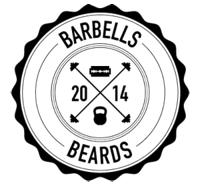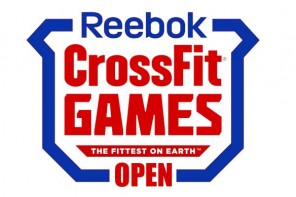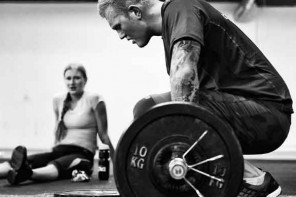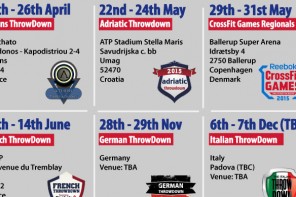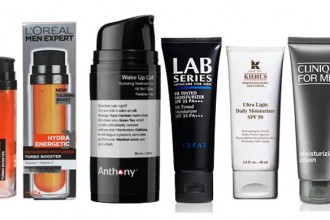The Best WeightLifting Shoes Of 2024
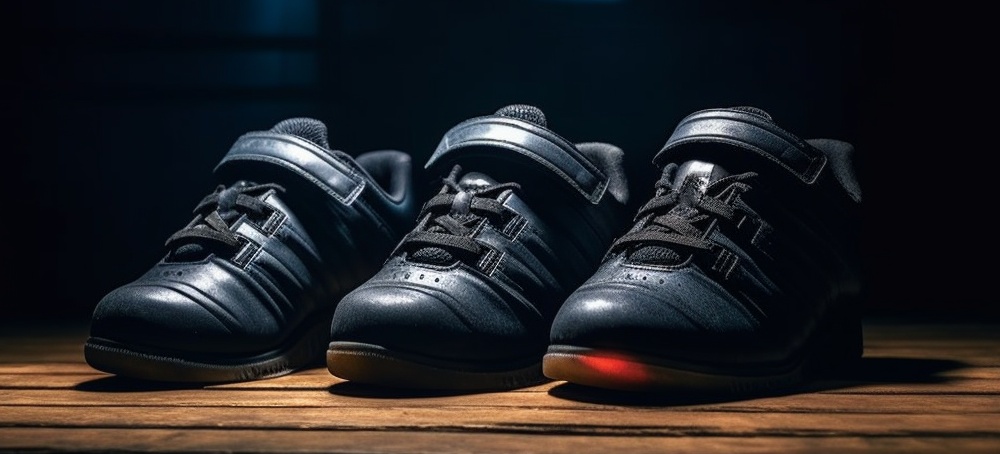
Weightlifting shoes are special shoes designed to enhance your performance and safety when lifting heavy weights, but finding the best weightlifting shoes for your needs can be a minefield, but we’re here to help.
Weight lifting shoes are not only beneficial for Olympic lifts, such as snatches and clean and jerks, but also for other compound movements, such as squats, deadlifts, bench presses, and overhead presses. They can help you improve your form, technique, strength, and mobility. They have a few features that distinguish them from regular shoes, such as:
– A raised heel that allows you to squat deeper, maintain a more upright posture, and activate more muscle fibers.
– A hard, flat sole that provides stability, traction, and power transfer.
– A snug fit and a strap system that secures your foot and prevents unwanted movement.
– A durable, breathable upper that withstands wear and tear and keeps your feet comfortable.
We review eight of the best weightlifting shoes of 2024 based on their features, benefits, quality, and customer reviews. We will also give you tips on choosing the right pair of weight-lifting shoes for your needs.
Summary
Best Overall Weightlifting Shoe – Nike Romaleos 4
Best Weightlifting shoe for Beginners – Adidas Powerlift 5
For Weightlifting Shoe for Narrow Feet – Adidas Adipower 3
Best Weightlifting Shoe for wide Feet – Reebok Legacy Lifter 2
Best Weightlifting Shoe for Olympic Lifts – Adidas Adipower 3
Best Weightlifting Shoe for CrossFit – Nike Metcon 8
Best all rounded Weightlifting Shoe – Inov-8 Fastlift 360
Best Weightlifting shoe on a Budget – Adidas Powerlift 5
Best Overall Weightlifting Shoe
Nike Romaleos 4
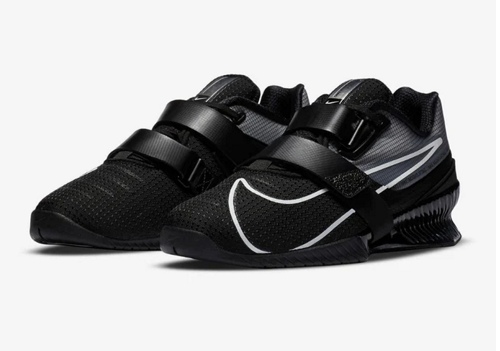
The Nike Romaleos 4 is the latest version of Nike’s popular weightlifting shoe line and has been worn by elite lifters around the world. It is designed to provide stability, performance and comfort for heavy weightlifting. The shoe has a 20mm heel-to-toe drop, ideal for Olympic lifts and squats. It also has a dual strap system that allows you to adjust the fit and support of the shoe according to your preference. The upper of the shoe is made of a woven fabric that is durable and breathable.
Pros:
- Solid & grippy outsole giving a stable platform that prevents slipping.
- Wider toe box giving more room for toe splay and comfort.
- Heavy & sturdy build giving stability and confidence in lifts.
- Modern & sleek look that comes in various colors.
Cons:
- More expensive than a lot of other shoes on our list
- Heavily specialized
- Not good for beginners
Verdict:
The Nike Romaleos 4 is a great weightlifting shoe for serious lifters who want stability, performance, and style. If you are looking for a pure weightlifting shoe that can handle heavy loads and provide a solid base, the Nike Romaleos 4 is the shoe for you. If you can hold out a while, the Romaleos 5 are also looking pretty special.
Best Weightlifting Shoe for Beginners
Adidas Powerlift 5
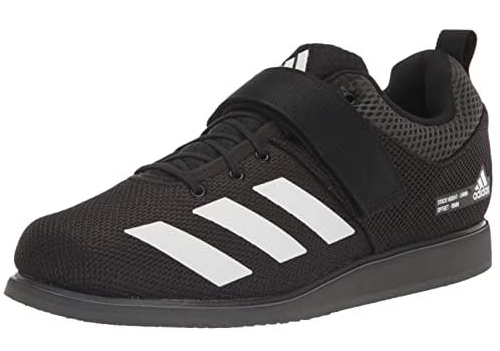
The Adidas Powerlift 5 is a weightlifting shoe with a 15mm heel height, a high-density EVA sole, and a stretch canvas upper with mesh inserts. It is designed to provide stability, traction, and comfort for lifters who are just getting into elevating the heels for squatting. It is also the most affordable shoe on our list.
Pros:
- Good grip on gym floors & can handle multiple lifts
- Supportive strap that secures the foot and prevents slippage.
- Breathable and flexible upper that adapts to the foot shape.
- Durable structure for longevity
- Extremely versatile
Cons:
- Long break-in period and may feel too stiff at first.
- Narrow toe box that may not suit wider feet.
- Not suitable for advanced lifters who need more heel elevation.
Verdict:
The Adidas Powerlift 5 is an excellent beginner-friendly lifting shoe that offers stability, traction, and comfort at a reasonable price. It is ideal for those new to lifting with an elevated heel or who want a versatile shoe for different workouts. However, there may be better choices for those who have wider feet, need more heel height, or seek more comfort and flexibility.
Best Weightlifting Shoe for Narrow Feet
Adidas Adipower 3
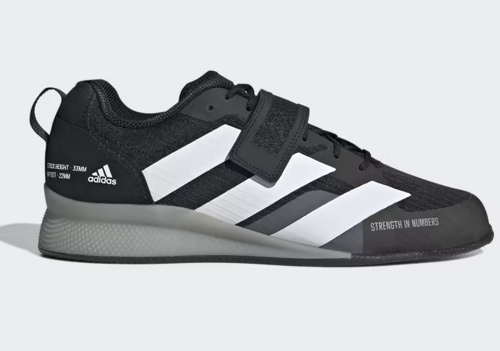
The Adidas Adipower 3 is the latest version of the iconic weightlifting shoe worn by many Olympic champions and elite lifters. It is designed to provide stability, support, and comfort for heavy lifting sessions. It has a few features that make it stand out from other weightlifting shoes, such as:
A 22mm elevated heel made of TPU material for optimal power transfer and squat depth.
A mesh upper that is lighter and more breathable than previous models, with synthetic overlays for durability and protection.
A lace closure and a midfoot strap ensure a snug and secure fit, with a padded tongue and collar for comfort.
A rubber outsole that offers grip and durability on various surfaces, with a flexible forefoot for natural movement.
This is one of our most expensive options; however, it may be worth the investment if you are looking for a high-quality and reliable shoe that can handle any weightlifting challenge.
Pros
- Great for narrow feet
- Stable and supportive heel
- Breathable and durable upper
- Snug and secure fit
- Grippy and flexible outsole
- Stylish and customizable design
Cons
- Expensive
- Not good for wide feet
- May require some break-in time
Verdict
The Adidas Adipower 3 is an excellent choice for serious lifters who want a stable, supportive, and comfortable shoe that can handle heavy weights. It has a proven performance and quality track record, with a stylish and customizable design. There may be better options for those who have wide feet or are on a tight budget, but it is definitely one of the best weightlifting shoes on the market.
Best Weightlifting Shoe for Wide Feet
Reebok Legacy Lifter 2
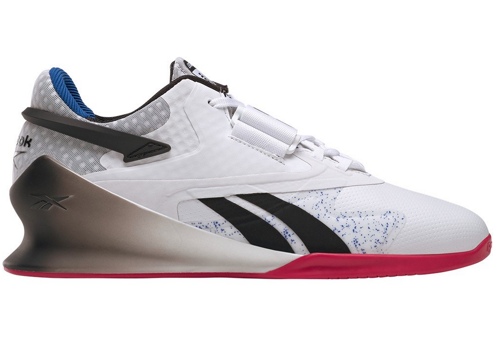
The Reebok Legacy Lifter 2 shoe is a specialized weightlifting shoe that offers great stability, support and grip for heavy lifting. It is an upgraded version of the original Reebok Legacy Lifter, which was designed in collaboration with four-time CrossFit Games champion Tia-Clair Toomey.
It has a rigid, reinforced heel that anchors the foot to the ground and a thick velcro strap that provides a snug fit. The shoe has a flat outsole with minimal, concentric grips that are ideal for static lifting.
The shoe also has a large toe box that some may find too spacious and uncomfortable.
Pros:
- Great for wide feet
- Great for longer sessions
- Great stability and support for heavy lifting
- Hard, reinforced heel that anchors the foot to the ground
- Thick velcro strap that provides a snug fit
- Flat outsole with minimal, concentric grips that are ideal for static lifting
Cons:
- Large toe box that some may find too spacious
- At a higher price point of our lifters featured
- Not good for narrow feet
Best Weightlifting Shoe for CrossFit
Nike Metcon 8
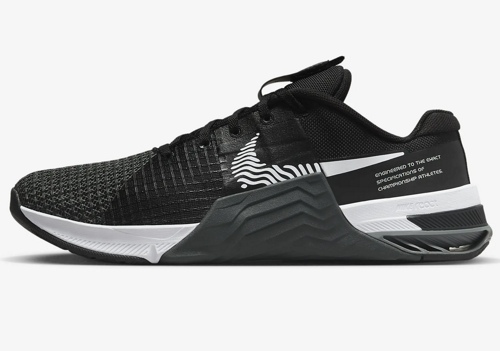
The Nike Metcon 8 is the latest edition of the popular cross-training shoe line designed for CrossFit, lifting and HIIT workouts. It has a few improvements over the previous Metcon 7, such as a more breathable upper, a lace lock system and a more durable toe box. It also has the same Nike React foam in the sole, providing cushioning and responsiveness for jumping and running.
The main strength of the Metcon 8 is its stability and support for heavy lifts and explosive movements. The shoe has a flat, wide base that grips the floor well and a heel clip that helps with handstand push-ups and wall walks. The shoe also has rubber around the sides for rope climbs and a Velcro strap to secure the laces.
The main weakness of the Metcon 8 is its need for more flexibility and comfort for longer runs or sprints. The shoe is quite stiff and tight-fitting, which can cause some pressure on the toes and arches. The sole is also not very flexible, which can limit the foot’s natural motion.
Pros:
- Stable and supportive for lifting and CrossFit
- Breathable and durable upper
- Lace lock system and heel clip
- Good grip and traction
Cons:
- Stiff and tight-fitting
- Not very flexible or comfortable for running
- Expensive
Verdict:
The Nike Metcon 8 is an excellent shoe for CrossFit athletes and lifters who want a stable and versatile shoe for their gym workouts. It has some nice features that improve its performance and durability over the previous generation. However, it is not a good shoe for runners or anyone who prefers a more flexible and cushioned shoe. It is also quite pricey compared to other cross-training shoes on the market. If this sounds like the shoe for you, you might want to also consider the Nike Metcon 9.
Most Versatile Weightlifting Shoe
Inov-8 Fastlift 360
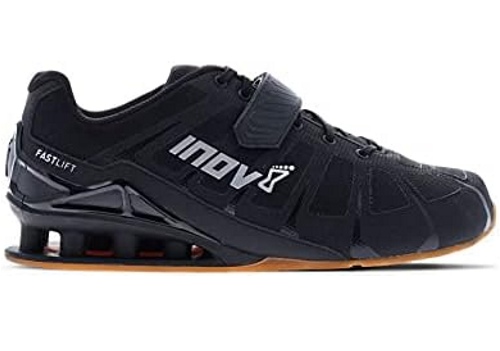
The Inov-8 Fastlift 360 is a versatile and lightweight weightlifting shoe that offers a balance of stability, protection and flexibility. It is suitable for beginners and experienced lifters alike, as well as for cross-training and functional fitness.
The shoe features a durable, breathable upper that wraps around the foot and provides a snug and comfortable fit. The upper also has a TPU heel cage that locks the heel in place and prevents slippage during heavy lifts. The shoe has a wide toe box that allows the toes to splay naturally and enhances grip and balance.
The Inov-8 Fastlift 360 has a dual-density midsole with soft EVA foam in the forefoot and a firmer TPU wedge in the heel. The EVA foam provides cushioning and shock absorption, while the TPU wedge offers stability and support. The shoe has a low heel-to-toe drop of 16.5 mm, which is ideal for weightlifting as it allows for a deeper squat position and better ankle mobility.
It has a rubber outsole that is durable and grippy, with a Meta-Flex groove in the forefoot that allows for natural flexion. The outsole also has a Power-Truss system that consists of eight pillars that form a solid base for lifting. The outsole provides traction and stability on various surfaces, such as wood, rubber and carpet.
Pros:
- Lightweight and flexible
- Stable and supportive
- Durable and breathable
- Comfortable and snug fit
- Wide toe box
- Low heel-to-toe drop
- Grippy outsole
Cons:
- May run small or narrow for some people
- May not be suitable for running or jumping
- May not be very stylish or colorful
Verdict:
The Inov-8 Fastlift 360 is a great weightlifting shoe that can also handle other types of training. It is light, flexible, stable, supportive, durable, breathable, comfortable and grippy. It has a low heel-to-toe drop for better squatting and ankle mobility. It has a wide toe box that lets the toes spread naturally and improves balance. It may run small or narrow for some people, so it is advisable to try it on before buying. It may not be suitable for running or jumping, as it is designed for lifting. It may not be very stylish or colorful, but it has a sleek and minimalist design that looks professional. Overall, the Inov-8 Fastlift 360 is a high-performance weightlifting shoe that delivers on its promises.
What to Consider When Buying Weightlifting Shoes
Weightlifting shoes are specially designed footwear that can enhance your performance and safety when lifting heavy weights. Whether you are a beginner or a seasoned lifter, you need to consider some factors before buying a pair of weightlifting shoes. Here are some of the most important ones:
Budget:
The first and most obvious factor is how much you are willing to spend on weightlifting shoes. The price range can vary from less than $100 to over $200, depending on the shoe’s brand, model, quality and features. You need to decide how much you value your weightlifting shoes and how often you plan to use them. You don’t have to break the bank to get decent weightlifting shoes, but you don’t want to compromise on quality and durability.
Sport:
The second factor is what kind of sport or activity you buy weightlifting shoes for. Different sports have different demands and preferences when it comes to weightlifting shoes. For example, if you are mainly into powerlifting, you may want a shoe with a higher heel and more stability. If you are into Olympic weightlifting, you may want a shoe with a lower heel and more flexibility. If you are into CrossFit or functional fitness, you may want a shoe that can handle both lifting and other movements, such as running, jumping and agility drills.
Anthropometry
The third factor is your body proportions and measurements. Anthropometry refers to the study of the human body dimensions and how they affect movement and performance. Some aspects of anthropometry that can influence your choice of weightlifting shoes are your height, weight, leg length, foot size and shape, ankle mobility and arch type. For example, if you have long legs and poor ankle mobility, you may benefit from a shoe with a higher heel that can help you achieve a deeper squat position. If you have flat feet or low arches, you may need a shoe with more arch support or orthotics to prevent overpronation and injury.
Foot Shape
The fourth factor is your foot shape and preference. Foot shape can dictate which shoes and sizes you may want to buy. Some people have narrow feet, while others have wide feet. Some people have long toes, while others have short toes. Some people like snug and tight shoes, while others like them loose and roomy. You need to find a shoe that fits your foot shape comfortably and securely without causing blisters, pain or numbness. You can measure your foot length and width using a ruler or a Brannock device and compare them with the shoe size charts provided by the manufacturers.
Features of Weightlifting Shoes: What You Need to Know
Weightlifting shoes have unique features that distinguish them from other types of shoes, such as running, cross-training, or casual shoes. Here are some of the main features of weightlifting shoes and what you need to know about them:
Heel Height:
One of the most noticeable features of weightlifting shoes is their elevated heel. The heel height can vary from 0.5 to 1 inch, depending on the model and brand. The purpose of the raised heel is to allow you to squat deeper and more upright by increasing your ankle range of motion. This can improve your posture, stability and power during squats and Olympic lifts, such as snatches and clean and jerks. The heel height can also affect your balance and leverage, so you need to find the optimal heel height for your body proportions and lifting style.
Toe Box:
Another feature of weightlifting shoes is their wide-toe box. The toe box is the front part of the shoe that covers your toes. A wide toe box gives your toes more room to spread and splay naturally, enhancing your grip and balance on the floor. A wide toe box can also prevent your toes from getting squished or cramped during heavy lifts, which can cause pain, blisters or numbness.
Strap System:
A third feature of weightlifting shoes is their strap system. Most weightlifting shoes have one or two straps across the mid-foot or the upper part of the shoe. The straps are usually made of Velcro or leather and can be adjusted to tighten or loosen the shoe’s fit. The straps provide extra security and stability by locking your foot in place and preventing it from sliding or moving inside the shoe. The straps can also help you customize the fit and comfort of your shoe according to your foot shape and preference.
Heel Material
A fourth feature of weightlifting shoes is their heel material. The heel material is what makes up the base or the sole of the shoe. The heel material can be either hard or soft, depending on the type and quality of the shoe. Hard heel materials are usually wood, plastic or metal, while soft heel materials are generally rubber, foam or EVA3. Hard heel materials provide more stability and support by creating a solid and rigid base for lifting. They also transfer more force and power from your feet to the floor by minimizing compression or deformation. Soft heel materials provide more cushioning and shock absorption by creating a more flexible and responsive base for lifting. They also reduce impact and stress on your joints by allowing some compression or deformation.
Outsole Design
A fifth feature of weightlifting shoes is their outsole design. The outsole is the bottom part of the shoe that touches the floor. The outsole design can affect the traction and grip of your shoe on different surfaces, such as wood, rubber or carpet. Some outsoles have a flat and smooth design, while others have a textured or patterned design. Some outsoles have a Meta-Flex groove in the forefoot, which allows for natural flexion during lifts. Some outsoles have a Power-Truss system, which consists of pillars that form a solid base for lifting.
